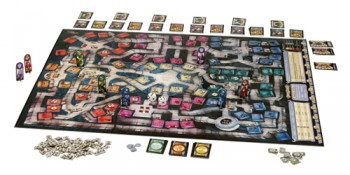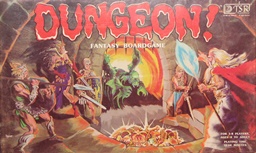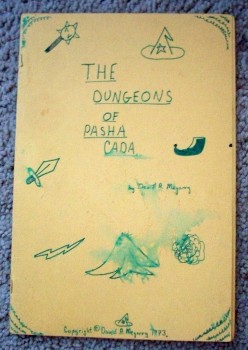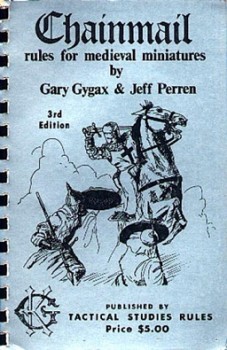The Public Life of Sherlock Holmes: Dungeon! – A New Kind of Board Game
 TSR’s Dungeon! came out in 1975, just one year after Gary Gygax revolutionized gaming with Dungeons and Dragons.
TSR’s Dungeon! came out in 1975, just one year after Gary Gygax revolutionized gaming with Dungeons and Dragons.
The ground-breaking board game is still an excellent introduction to fantasy gaming over forty years later. The board represents a dungeon, divided into six areas (representing levels) of varying difficulty, differentiated by color. There are monster and treasure cards for level and the harder the level, the tougher the monsters and of course, the greater the treasures.
The character classes have been changed over the years, but the player chooses from a Rogue, Cleric, Fighter and Wizard and each class needs to collect a certain amount of gold pieces (earned from treasure cards), ranging from 10,000 to 30,000. Also, each hero class performs at its best in certain levels. So you don’t want to take a Cleric to level six, but your Wizard is never going to win by traipsing around level one.
When a hero enters a room or a chamber, they draw a monster card (which might also be a trap). Every monster has a value assigned to each hero (as well as two spell values for the Wizard). The player rolls two six-sided dice and wins on a tie or greater. The monster is dead and the player gets a treasure card. If the Hero loses the fight, one of five things happens, ranging from nothing to dying and losing all of their treasure. The monster and any treasures remain in the room, waiting for another hero to enter.
Heroes explore until they gain the required amount of treasure for their class. The first Hero to make it back to the starting chamber with the requisite treasure wins the game. Bad things can happen on the way back to the starting chamber and the Hero may no longer have enough treasure. And once in awhile, it becomes a race to the finish.
Ross Maker shows you how to play what looks like the first edition of Dungeon! here.
The apparent simplicity of Dungeon! is misleading and is really a tribute to its designer, Dave Megarry, who features prominently in the second part of this post, about the history of Dungeon!
By contrast, I enjoy the Dungeons and Dragons Adventure Board Game series: Wrath of Ashardalon, Legend of Drizzt and Temple of Elemental Evil (I haven’t played Castle Ravenloft). But, excepting Temple, they are all static leveled. The Hero is first level, with the potential to level up to second, during the adventure. That’s it. Monsters are of various difficulty and are randomly drawn (with the exception of the powerful villain, who is usually encountered by a specific end-game trigger. A hero could run into a goblin in one room and a troll in the next.
Now, there’s nothing wrong with that, and these games are very fun. Temple is different because it is built on a campaign mode in which your character can increase its powers over multiple linked scenarios, so it accounts for levelling.
But Dungeon! addresses multi-level competition within the same game, without completely changing the mechanism. This is achieved by:
Multiple Zones/Levels of varying difficulties
Varying levels of Heroes
Staggered treasure requirements
Treasure amounts determined by level
 So, a Rogue spends most of their time exploring the first two levels, battling lesser monsters for small treasures, trying to amass 10,000 gold. They might venture down to level three for a battle or two, increasing the treasure haul but also running into considerably tougher opposition.
So, a Rogue spends most of their time exploring the first two levels, battling lesser monsters for small treasures, trying to amass 10,000 gold. They might venture down to level three for a battle or two, increasing the treasure haul but also running into considerably tougher opposition.
Meanwhile, the Fighter delves deeper, down to levels four and five, going against tougher opponents but picking up better treasures as they hurry towards 20,000 gold. The balancing of treasures, monsters and Hero abilities was no small feat and Dave Magerry should be congratulated for doing it so well (with some help from Gary Gygax and a few others at TSR). A player can win with any of the Heroes: that is some fine game design.
When I play this with my son, we use minis, which definitely adds to the fun. While there is no role playing (though my son does a running hero commentary when he plays), the game contains the dungeon crawl and monster combat elements of an RPG. The rules are simple and clear (contrast that with the confusion around a game of Munchkin!), yet there’s enough strategy to keep adults interested.
Dungeon! established a board game genre that is flourishing today. It broke new ground in being portable, easy to learn and play and it didn’t require a referee – everybody got to play.
It’s the one I constantly refer people to when they ask about a good introductory game for kids. Often the question is about RPGs, but I still suggest this as a first step through the doorway. The fire will be lit and the next step is into the complexity of actual RPGing and the associated rules. The Dungeons and Dragons Adventure Game line is similar in this function, but Dungeon! is simpler and it’s been around for a long, long time. And after all these years, I still enjoy playing it.
It Was Originally Called Dungeons of Pasha Cada
Back in 1972, Dave Arneson was up in Minnesota, reconfiguring Gary Gygax’s Chainmail: The Fantasy Supplement (precursor to Dungeons and Dragons), adding what we now know as a ‘dungeon crawl.’ Gygax, of course, was developing the rules in Lake Geneva, Wisconsin. Arneson’s Blackmoor campaign would become a key part of the original Dungeons and Dragons rules set. The two men took very different approaches, as Arneson was pretty much making things up on the fly: he was not an OCD-type of rules developer. This difference was a key, but not the only, element in their difficulties with each other.
 One of Arneson’s players, David Megarry, simplified Arneson’s rules (which were changes to the Chainmail rules) and turned the Blackmoor dungeon adventure into a board game, The Dungeons of Pasha Cada. And that is where we begin for a look at Dungeon!
One of Arneson’s players, David Megarry, simplified Arneson’s rules (which were changes to the Chainmail rules) and turned the Blackmoor dungeon adventure into a board game, The Dungeons of Pasha Cada. And that is where we begin for a look at Dungeon!
Gygax talked to Megarry about, Pasha Cada and he liked it. Gygax described it as “…a board game where each player takes the role of a fantasy character: a Wizard, a Hero, a Superhero, or an Elf. You move them on a board through a six-level dungeon. You enter the room and fight the monster and have to roll on 2d6, pretty much the way Chainmail operates.”
There were two great strengths to Pasha Cada that remain relevant today. It was portable and it was easy to learn. Bear in mind that it was the first of its kind. There were no other fantasy board games like it out there. To play The Fantasy Supplement, you had to learn how to play Chainmail, which was a medieval wargame, first. Dungeons and Dragons didn’t exist yet.
Megarry had boiled down the elements of The Fantasy Supplement, taken the dungeon crawl aspect of Arneson’s Blackmoor campaign and created a board game with multiple zones, which allowed characters of different levels to compete against each other. This was a significant accomplishment! Gygax invited Arneson and Megarry (the two Daves) to visit him in Lake Geneva. Arneson was already working with Gygax on Don’t give up the Ship!. It seems reasonable to assume that the Daves viewed it as a chance to showcase Blackmoor and Pasha Cada as viable games, while Gygax wanted his knowledgeable group to play both with an eye towards their commercial potential.
In November of 1972, the two Daves drove down to Lake Geneva. By far, the most significant part of the visit was Arneson’s running of Blackmoor. Gygax, his son Ernie and Rob and Terry Kuntz, along with Megarry, played characters. Some of the now standard practices of an RPG session came out of this experience. Arneson was the referee and played all of the monsters himself (it was not uncommon in his Minnesota sessions for the players to also run the monsters) and the party were allies.
Players were often rivals competing for dominance in Arneson’s home campaign. So, Gary Gygax found himself in a dungeon crawl, allied with the other players, working against an all-encompassing Game Master. That’s pretty important! Gygax later said of this session, “When I played his ‘Blackmoor’ campaign, I fell in love with the new concept.’”
That weekend, the group also played Dungeons of Pasha Cada. One has to wonder if it was lost somewhat in the huge shadow that Blackmoor cast. However, it did have the advantage of being a bit more familiar to Gygax. Arenson had taken Gygax’s clear, ordered rules and turned them into an almost whimsical set of guidelines implemented by him as he saw fit. Arneson didn’t even hand out copies of the rules to the players for that first session. He just got them going.
But Gygax could clearly see the rules and concepts of Chainmail Fantasy in Megarry’s game. The rules were clearly defined. The Dungeons of Pasha Cada really did take the nature of Arneson’s revolutionary dungeon crawl and clearly apply a framework of rules drawn from Chainmail Fantasy into an easy to learn board game. While this may not seem revolutionary within the framework of Chainmail Fantasy and Blackmoor, it is in every other aspect.
Role Playing Games did not exist yet. There was not a single fantasy board game out there. Pasha Cada was breaking new ground. You’ve got to think that Gygax absolutely recognized the potential for a dungeon crawl board game like Pasha Cada to serve as an introduction to new players, leading them to the more complex Chainmail Fantasy. Also, since it was competitive, it offered a contrast to Arneson’s cooperative campaign.
 Clearly, the weekend had a major impact, as Gygax later said, “Between those two games, that’s how D&D was born.” Also, “I was enthused, and said I was going to create a full-fledged set of fantasy game rules.” He intended to “design a special game system, to manage something new.”
Clearly, the weekend had a major impact, as Gygax later said, “Between those two games, that’s how D&D was born.” Also, “I was enthused, and said I was going to create a full-fledged set of fantasy game rules.” He intended to “design a special game system, to manage something new.”
Gygax refined Megarry’s game and tried to land it with Guidon Games, publisher of Chainmail. Owner Don Lowry liked the game, but was not willing to bet his small company’s future on an out-of-the-genre game from an unpublished designer.
Then, in one poorly thought-out rejection, Avalon Hill turned down Gygax’s offer to publish Dungeons and Dragons and Pasha Cada. It was Avalon Hill’s “no” that resulted in Gygax forming TSR to publish Dungeons and Dragons.
Gygax would finally publish the game through his own TSR (Tactical Studies rules) as Dungeon! in 1975, introduced at the very first Origins. Wizards of the Coast last reissued this venerable game in 2014 and it is still a treat to play and a great gateway game for Dungeons and Dragons (and other RPGs).
Dungeon! is the ancestor of all dungeon crawler board games. Descent!, Runebound, the Dungeons and Dragons Adventure Board Game line, Talisman, Dungeonquest, and Star Wars: Imperial Assault: these all find their roots in Dungeon! TSR had a major innovation in not one, but two areas of the gaming industry in 1974-1975.
Dave Megarry himself talks about Dungeon! and gives some info on the origins of Blackmoor as well.
Other Game/RPG-related posts I’ve done here at Black Gate:
The Lost Lands for Pathfinder
The Northlands Saga – Complete
The Warlords of the Accordlands
Judges Guild Premium Editions
Gary Gygax’s Role Playing Mastery
Munchkin!
Runebound
Runebound – The Sands of Al-Kalim
Runebound – The Mists of Zangara
Necromancer Games (Part One of two)
Frog God Games (Part Two of two)
Dungeons and Dragons Adventure Game System
D&D Adventure Game System – Temple of Elemental Evil
Sherlock Holmes: Consulting Detective
221B Baker Street: The Master Detective Game
Conan: Age of Exiles
You can read Bob Byrne’s ‘The Public Life of Sherlock Holmes’ column here at Black Gate every Monday morning.
He founded www.SolarPons.com, the only website dedicated to the ‘Sherlock Holmes of Praed Street’ and blogs about Holmes and other mystery matters at Almost Holmes.
He is an ongoing contributor to The MX Book of New Sherlock Stories series of anthologies, with stories in Volumes III, IV and the upcoming V.
I just bought the 2014 version of the game for my nephew. He’s been asking for board games to play. Hopefully this one works out.
Glenn – That’s the version I have and play with my son (I think he was 6 when we started). I think it’s a great intro for kids.
We put minis on the board when we draw a monster card, which he really likes.
One thing is he doesn’t want to play competitively. So, we do a co-op dungeon crawl. It pretty much guarantees we win, but at least he’s playing.
I moved him up from Dungeon! to Wrath of Ashardalon and he had no trouble with it. I think Dungeon! laid the groundwork.
How old is your nephew? Please post a follow up after he plays it.
He will be 8. I’ll be giving it to him as a birthday present this Sunday. Hopefully we ll be able to play it soon after.
[…] Today over at BlackGate.com, I did into the history of this venerable board game. It came directly out of Dave Areneson’s Blackmoor sessions and really, pre-dates D&D. […]
Hmmm… the 2014 edition is less than $20 on amazon, and I have a 7-year old daughter (and I’ve successfully gotten her into Star Wars already) so maybe this one will be a good next step…
And I can supplement with all the minis from the Monolith Conan game coming this winter (well, some of the minis… some might be a bit edgy for a 7-year old…)
thehessiangoeshome – I thought about that Monolith Conan game but the price was a bit steep.
I did back the new Conan RPG from Modiphius and it looks sweet.
Post back if she gives Dunegon! a try. It really is a good kids game and a gateway to RPGing.
Great post! Reaplying Dungeon now and reminiscing. I never heard of the Pasha Cada. Thx to Bob and Blackgate for these articles.